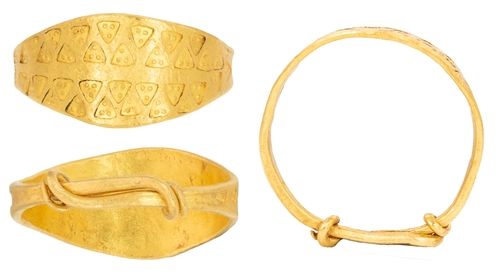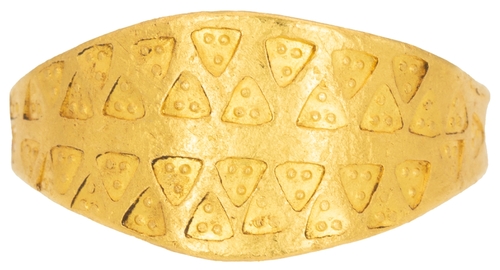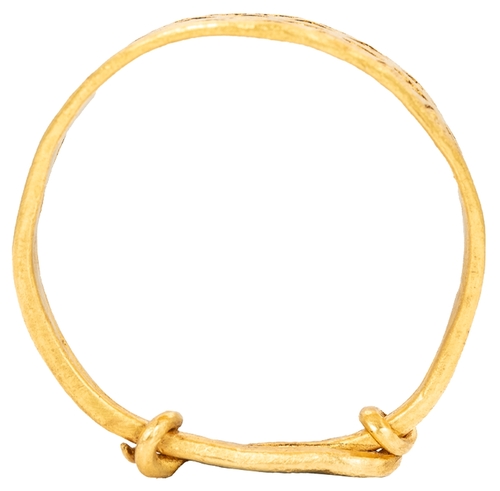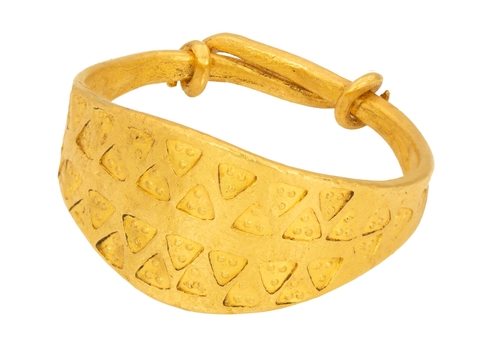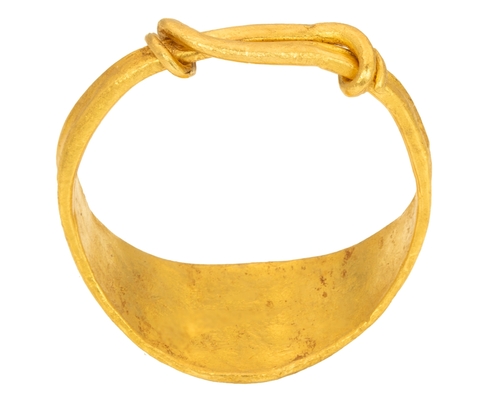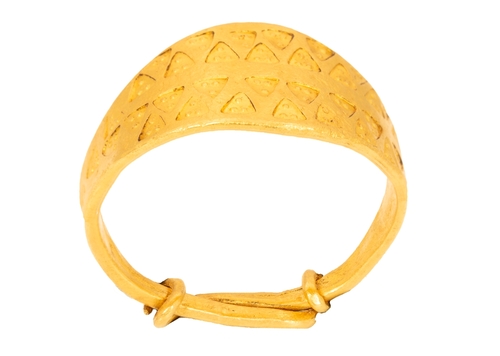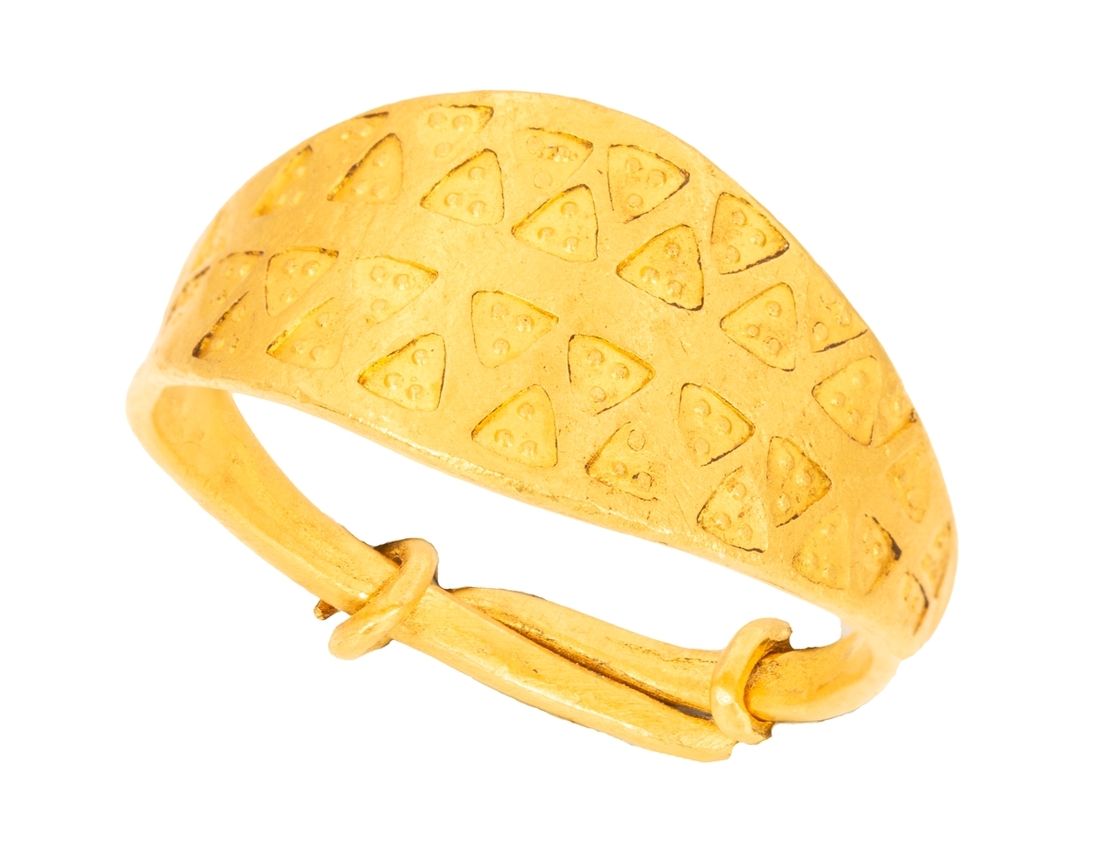Auction: 25055 - British Medals and World Coins featuring The Hurter-Amman Collection of Ancient and European Gold
Lot: 706
Large Viking Gold Ring with Punched Pelleted Triangles (c. 800-1000), bowed lozenge bezel with shoulders and loop that taper to pointed terminals with rounded edges, each overlap and extend into a loop around the opposite terminal, potentially to allow for adjustment of fit, the bezel and shoulders neatly decorated with four lines of closely spaced punched triple-pelleted triangles, external diameter 28mm, internal diameter 25mm, length 27.2mm, thickness 1.5mm, 9.99g [154.17grns], ring size approx. 16 ¼ USA, [Spink XRF: 97.24% Gold; 1.93% Copper; 0.83% Silver] (cf. BM 2010,8015.1 = cf. DCMS Treasure Annual Report 2004, no. 86; cf. PAS: DENO-9A6C17, SWYOR-56EA98, SWYOR-B1A3B8; BH-59ECD3), this ring is an impressive survivor of typical Viking jewellery of the last 9th-10th centuries, and is in incredibly impressive condition, sturdy and wearable (if not very large), certainly the most fine of similar rings registered with PAS, extremely rare
Provenance
Found in Little Munden (East Hertfordshire), 1979
~ Recorded with the British Museum (ref. PAS-BH-BB9233) ~ disclaimed as Treasure under the law of Treasure Trove in place at the time of finding
https://finds.org.uk/database/artefacts/record/id/1148440
According to XRF analysis, the gold purity is 97.24%
The ring was originally found in July 1979 by a metal detectorist searching in Dane End (Little Munden), Hertfordshire. After the finder's death in 2018, the ring changed hands twice before the current vendor contacted the Portable Antiquities Scheme (PAS) to ensure the correct procedures had been followed. Although the name 'Dane End' might initially conjure images of Viking raiders, it derives from 'Dene End', meaning 'Valley End', a reference to its location where a branch of the River Lea cuts through the surrounding landscape.
The Vikings have long captivated the imagination of historians and collectors alike, and few artefacts evoke their world more vividly than the jewellery that adorned their warriors. This large ring, dated to c. 800-1000 CE, offers an extraordinary glimpse into the artistic sophistication and metallurgical skill of craftsmen at the time. Striking in both scale and preservation, it exemplifies high-status adornment and is a rare survivor from a turbulent historical era.
Exceptional in both design and execution, the ring weighs just over 10 grams and is crafted from gold of remarkable purity - over 97%, with trace amounts of copper and silver. With an external diameter of 29mm and a UK ring size of Z8 (US 16¼), it is unusually large. Its construction demonstrates a refined understanding of form and function. Dominating the design is a lozenge-shaped bezel with a convex bow, its flat face framed by four linear rows of punched triple-pellet triangle motifs arranged in almost perfect symmetry. These motifs are not merely decorative - they reflect a key stylistic hallmark of Viking metalwork, blending symbolism, geometry, and precision.
While Viking metalwork often features stylised animals, knotwork, and geometric patterns, the triple-pellet triangle may carry symbolic weight. Some scholars link such motifs to Norse mythology - perhaps referencing the Valknut, associated with Odin - though interpretations remain speculative. What is certain, however, is that the sharply defined, evenly spaced design reflects an artisan's meticulous hand, in stark contrast to more commonly seen examples where stamps overlap or appear randomly placed. Such a level of craftsmanship strongly suggests the ring was made for a member of the elite. In a very real sense, it is solid-gold proof that in a world of warriors and wanderers, the Vikings still prized beauty.
The ring's shoulders taper to pointed terminals that overlap and curl around each other, interlocking loops that likely allowed for size adjustment. This practical feature underscores the dual nature of the ring: both ornamental and functional. The interior is left plain and smoothly finished, offering a comfortable fit. Remarkably, despite its age - over a thousand years - the ring is in superb condition. Where many ancient artefacts bear the marks of corrosion or burial damage, the surfaces here remain crisp, preserving the intricate decoration with near-original clarity.
It fits well within the broader corpus of Viking jewellery, with parallels recorded through PAS, such as the gold finger ring found in Nottinghamshire (DENO-9A6C17), and others from Yorkshire, Kent, and Norfolk. While another of similar form from Thetford offers further comparison. Even so, the Little Munden ring stands apart for its scale, completeness, and decorative quality. It is likely among the finest Viking rings recorded by PAS to date, a testament to elite craftsmanship and the importance of personal ornament in Viking culture.
The broader historical context only adds to its significance. The Viking Age was marked by exploration, conquest, and trade. From Scandinavia, Viking travellers reached as far as Newfoundland, North Africa, and the Volga River. Alongside weapons and goods, they carried with them a rich tradition of ornamentation.
Jewellery in the Viking world had multiple roles: it signified social status, functioned as wearable wealth, and could even serve as currency. Rings gained popularity in the later Viking era, with many being penannular (open-ended) for flexibility - ideal in a culture where jewellery might be loaned, traded, or worn over gloves. Though not all Viking rings were adjustable, their designs often reflect a careful blend of utility and aesthetics.
Material choice was equally significant. Viking jewellery incorporated both organic substances like bone and amber, as well as a range of metals. Gold was particularly rare and valuable, used sparingly and reserved for society's highest ranks. In contrast to the more widespread silver pieces of the period, gold rings like this one were potent statements of wealth and status, adding further weight to its importance.
Although the ring is more than 300 years old and made of gold, it falls under the older Treasure Trove law, rather than the current Treasure Act of 1996, due to the date of its discovery. Under those previous rules, only items intentionally buried with the intent of later recovery could be declared treasure. As this ring was likely lost rather than buried, it did not meet that criterion and was therefore disclaimed and returned.
Subject to 20% VAT on Buyer’s Premium. For more information please view Terms and Conditions for Buyers.
Sold for
£5,200
Starting price
£3200

